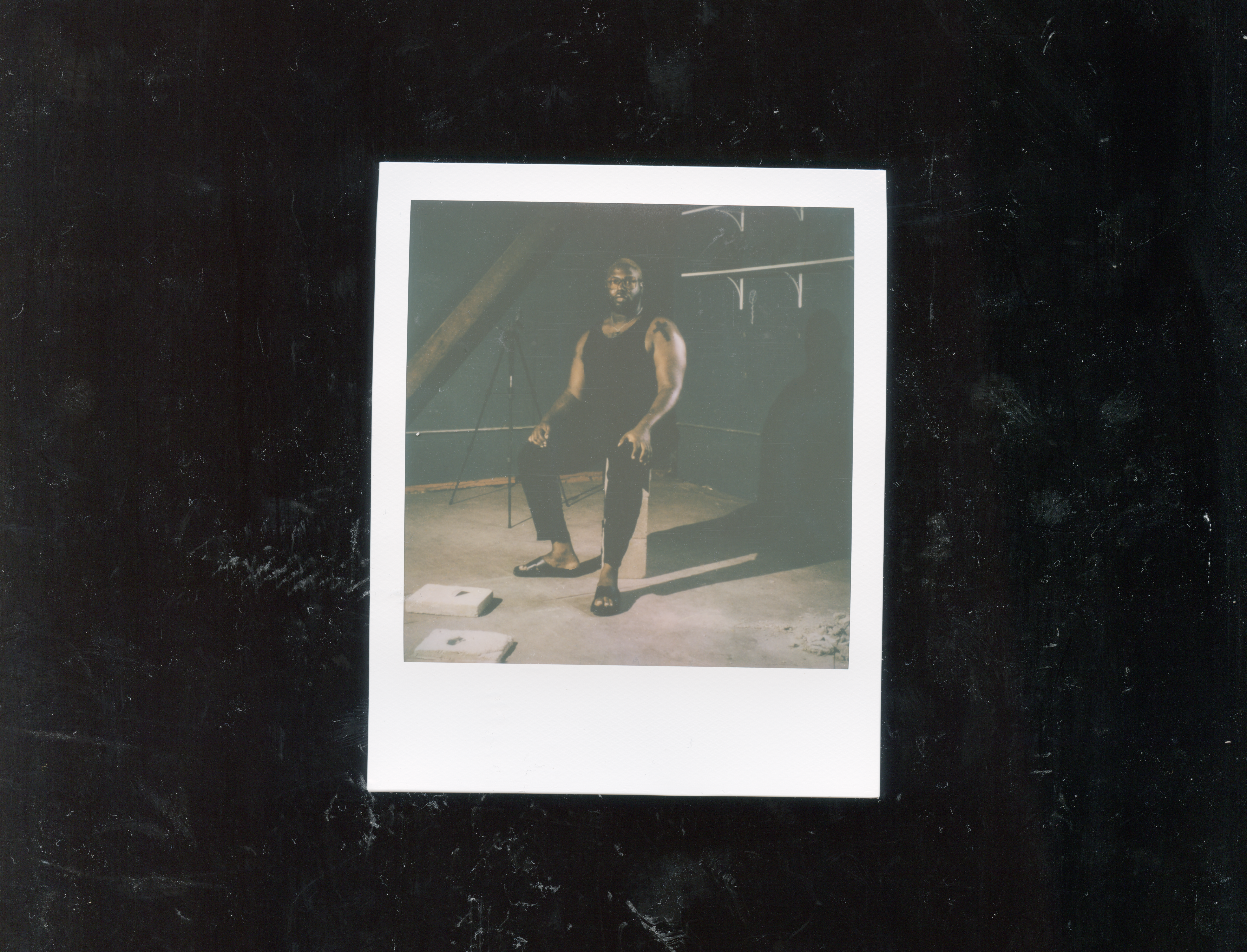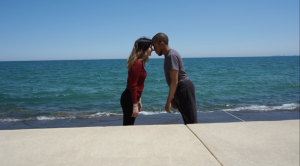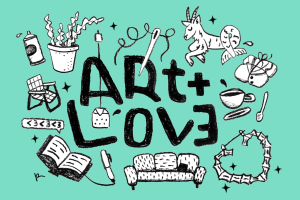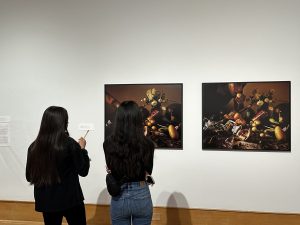I know the exact moment when an artist’s work becomes part of my mental repository of practices that I will forever return to. When I’m looking at the work, my mind is rushed with a thousand thoughts, the most revealing ones being the essays I start writing or the projects I start curating in my head.
This is what happens when I see Shabez Jamal’s work. My most recent mental blooms were watered by the sculptures, Page Reconstructions and Untitled, from their solo show Close Your Eyes, And Remember at Sibyl Gallery in New Orleans. When I take up the artist’s invitation to close my eyes, projected on the backs of my eyelids I can clearly see Shabez’s sculptures and compositions sharing space with the drawings and prints of another artist in my mental repository of forever-references, Darrel Ellis. Together, their work would speak to one another in a language of kin, finding threads of lineage between and toward one another from the opposite ends of nearly four decades.
I would re-read archivist Steven G. Fullwood’s essay The Case of the Artist’s Archive from the book Darrel Ellis (published by Visual Aids), which speaks to subarchives, family photo albums, and how private family archives circulate and change when they enter the public realm. I would think of Shabez’s Page Reconstructions and concrete encasements when reading about how Ellis’ family archives made it so that “through his artistic explorations, [Ellis] and his father entered into a conversation beyond space and time.” I would think about Shabez, and also their second-self and keeper of the archives, Anita, when Fullwood writes, “consider for a moment another kind of archival experience: Darrel as archive, an embodiment of his ancestry and experience.”
I would begin conversations with Shabez about the future of their own public family archive, and how it and their work, as Fullwood writes, “warrant a place among a constellation of Black family archives in an institution where Blackness isn’t marginal, it’s the universe.”
These echoes, calls, and conversations only exist as future dreams, all sparked before, during, and after a conversation I had in early May with Shabez. We covered so much ground, including how they remain rooted in Missouri despite living in New Orleans, how ethics and integrity impact their use of archival materials, and the act of acknowledging their grandmother and extended family as co-authors of the work.
This interview has been edited for clarity and length.
Tempestt Hazel: It’s currently spring—we’re deep into it. What does spring mean for you as a season?
Shabez Jamal: I think it’s changed since I’ve been [in New Orleans], because spring in New Orleans is much different than spring in St. Louis. In St. Louis, spring felt like a release of winter, all of the weight of the winter. Things started to bloom and become more green. But here, because things are verdant all year round, it feels like a continuation of something. It doesn’t feel as jarring, which in some ways I kind of miss. I miss seeing things come back alive. But in some ways I’m grateful that I don’t have to keep going through that—the death of winter. I’m conflicted because I love what spring does in the north and how it kind of puts you back in your body. Things are happening, time is moving. Spring, for me, is like a rebirth or a recharge of sorts.
TH: Speaking of change and transitions, two of my favorite things about your practice are the way you approach archival materials and how you move between mediums. And I’m always curious about the ways that origin stories influence creative choices. So, before we get into your work itself, I would love to start with your origin story.
SJ: So much of my work is inspired by my grandmother. During my undergrad, I was trying to figure out what my practice would look like. I noticed that I was referencing a lot of white men when making images. I started reading more about decolonizing my mind and decolonizing my practice. Throughout that work I had to [ask myself], “where is the place that I really got to experience what I consider high art?” It always came back to my grandmother’s house. My grandmother’s house was packed to the brim with photographs. My first experience with the photograph and my first time ever handling a camera was because of her. Because she didn’t have cable, I had to find ways to entertain myself that didn’t require the television. So, I would always go through her photo albums—sometimes with her, but most times by myself. I was able to recognize some faces and people—some cousins, aunts, my grandmother herself. But sometimes I would just notice the beauty of an image. Once I had the realization that my grandmother is the reason that I have this affinity for the image, I started to center my practice around how she made and organized images. Some of the images that I find myself being really attracted to now are the ones where she made a complete mistake. Instead of her discarding that image, she still put it in the album alongside the images that she found to be successful. She keeps everything. I’m so grateful for it now because I’m able to return to it, and to see how some of these things lend themselves to my own aesthetic decisions.
My grandmother’s house, [in] the home itself, things were fixed in a very haphazard way. She used duct tape as if it was a nail and a hammer, or super glue. She was very self-sufficient. The ways that the home was put together or maintained was through these impromptu [ways], very skilled to be able to make it last as long as she did. Sitting with that and understanding that my practice is rooted in this method of survival, that’s where the work that I’ve been making starts from now.
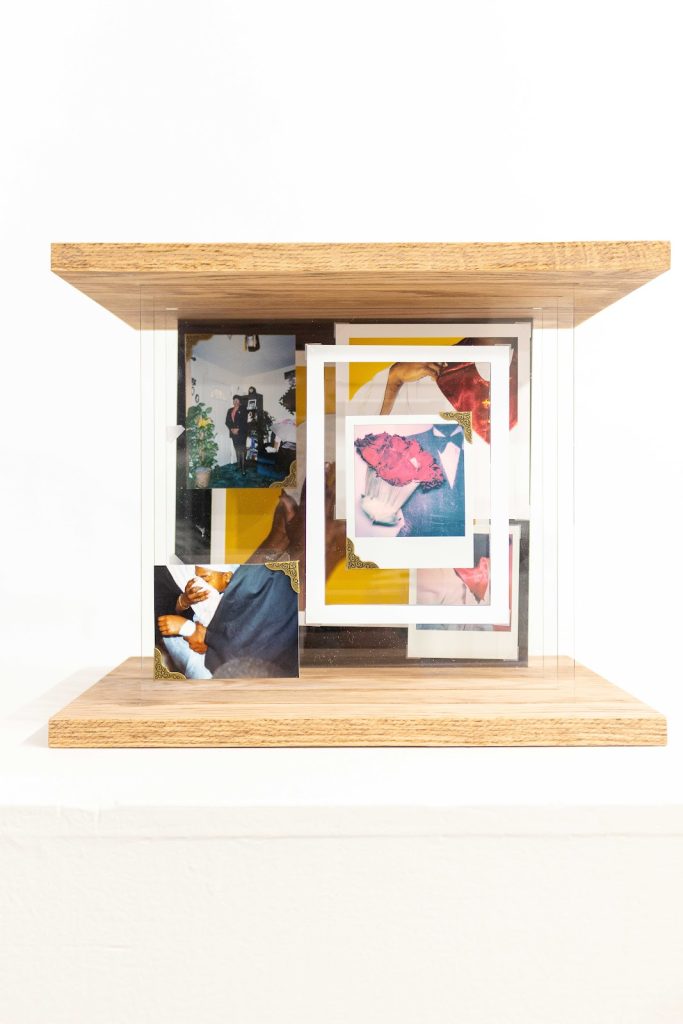
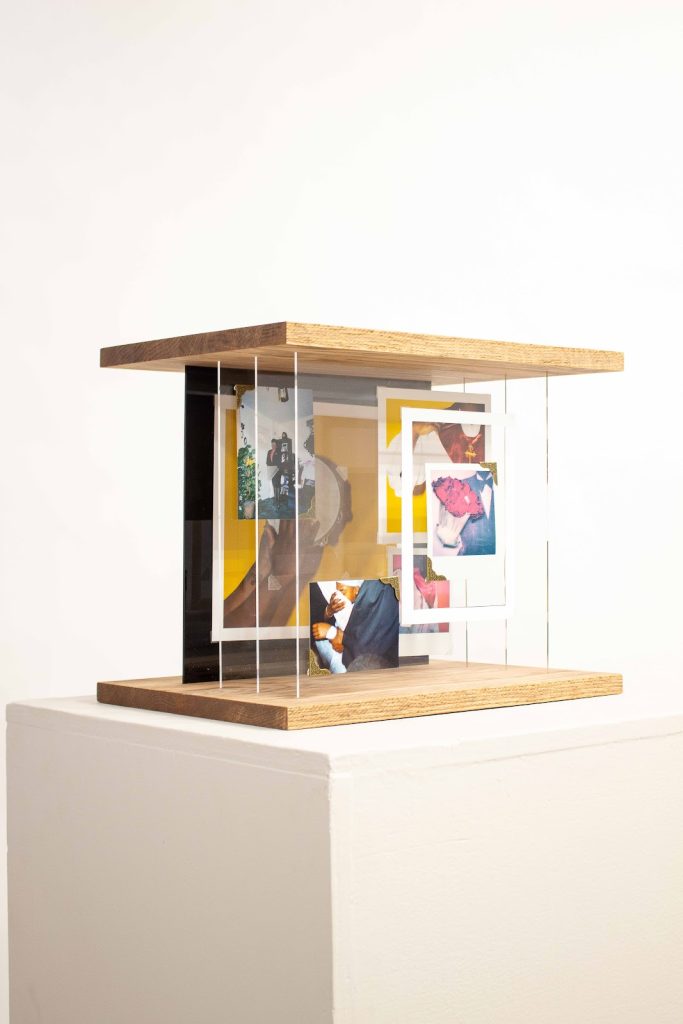
TH: You mentioned survival, which I think is a very inherent part of any kind of practice of memory work, preservation work, or archival work. When I think about preservation within the lives of certain folks, particularly Black folks and also queer folks, it’s impossible not to think about survival alongside any goals of creating physical reflections of your family. Could you talk more about what it was about your grandmother’s efforts to collect things that made you connect it to survival rather than simply, for instance, memory preservation?
SJ: I think it’s because, as it relates to Kinloch, [Missouri, the city is] a shell of itself. At one point, it was a city of around 10,000 people. Now it has roughly 250 people living in the city. My great-grandmother and my great-grandfather migrated from Alabama and settled in Kinloch. So the home that my great-grandmother and great-grandfather built, that’s where my grandmother was raised. They raised my mother there, and then when I was around 16, we moved into that house. Four generations of us have existed in Kinloch, through the demise of this city. Looking at those images, in so many ways they act as a counter to the existence and reality that I existed within when I was in that space. So, I feel grounded in that city even in the way that it is now because of those images, and because I know that we were here and we still are here and our presence is still felt in and amongst the abandoned homes and in the foliage that now has taken over the city. It acts as a way of surviving, of my family’s legacy and history surviving.
It operated as a space for us to go until recently. We lost the house to fire. But [before that] it was a place for cousins and aunts, my mother, my sister, and myself to go back to. That constant return back to this house also inspires me a lot in my work and how I return to images in the same way. I still return back to that [site] to make, just because it feels so comfortable. It’s a space, a plot of land that I can carve out and say, “this is us.” This is where we are, this is where we’ve been. It feels spiritual and magical for me in so many ways, even in the state that it’s in now.
TH: Four generations. That’s truly incredible. Does the rest of your family still see it as a place to return to in the same way that you do?
SJ: I don’t think so. Since my great-grandmother’s passing, it’s also just been a space of conflict for my family. It’s brought along a lot of grief to the family in so many ways. I think we do return to it mentally and emotionally. Those moments where we come back to the album, most of those memories that we return back to are based in that house. Maybe they do think of it as a space to return to, maybe just not in the same way that I think about it.
TH: Now, you’re living in a different location. I don’t know if you’re calling it home yet, but it’s a new place for you to be building during this period of your life. How are you cultivating home where you’re at now, and has your sense of home shifted?
SJ: So much. By moving down here, I had to really contend with the fact that home doesn’t exist in a physical space, and has never existed in a physical space with [a lot of] Black folks. So, moving down here and feeling out of my body, I did a lot of work to get back into this body and feel grounded in this body. Through that work I realized that home is this body. Home is the trauma that I carry, but also the love. Home is me on a cellular level and also a mental and spiritual level too. My relationship to or my understanding of home now is less about a physical space. And because of my relationship to the image, I can always return home by engaging with these images whenever I need to. Having that with me has allowed me to really settle into this space and feel grounded here for the time that I am here.
TH: If my understanding is correct, the basis of your work, or your starting point, was lens-based, and primarily photography. Over time, it’s moved into so many other directions, but all still point back to photography. You have intentionally reached outside of photography in such beautiful ways into, for instance, sculpture and collage, which is often just another expression of photography. I’m really interested in the evolutions of your material curiosities. Can you talk about the material scope of your work, where things started and how it got to the place that it is now?
SJ: During the graduate program [at Tulane University], I was really interested in building a home myself. I started watching architecture videos and my goal was to build a space. Then, I was like, “Girl, you really cannot do that. Let’s be realistic.” Realistically, I had to save a little bit more money. I couldn’t fabricate this outside of my own capacities. So, I started to sit with the elements that made up home for me. One of the first things I started to explore was the fridge (a.k.a. refrigerator) itself. I was thinking about how images kind of took over my grandmother’s house. That always was apparent through the refrigerator. Each magnet [held up] photographs. I remember being able to see myself as a baby and see photographs of myself even while growing up that I otherwise wouldn’t see, while I’m also nourishing my body. This was a fully embodied experience that I didn’t realize was as important to me as it was until I was in that program. I started thinking about ways to transform the fridge and make it speak to my existence as a queer black person. So I started making magnets from the photographs. That was my first experience making 3D objects from the images themselves. [In For Those Moments When Home Is Too Far], I started extruding the images and treating them almost as landscapes. I would then 3D print and make them into these cheap plastic magnets to adhere to the fridge and to also hold up other images.
So, I thought if I could do that with the fridge, I can also do that with other things. I spent an abundant amount of time in Kenloch. I was really interested in the things that still existed beyond [my family’s] presence. Most of the things that remained from houses were concrete foundations or concrete staircases. There’s something about the material of concrete. It’s this thing that’s supposed to exist well beyond us and is supposed to be structurally sound for such a long time, being the only remnant of these houses’ existence, these families’ existence.
It stuck with me. So I wanted to think about ways to incorporate concrete within the work that also felt natural. [For In Remembrance of Us], I started doing experiments with submerging images into concrete and then seeing what I can reveal after the image had been submerged, and using a really quick curing concrete still gave me an allotted amount of time to maneuver it before it solidified. That became another experiment that I’ve adapted into my practice.
TH: When I see your work, I think about the metaphors of the material. There’s, for instance, the historical, personal, and spiritual weight of these materials that record our lives, but they’re so precarious and they’re so losable, fragile and easily misplaced. It’s almost the opposite of something like concrete. But still, concrete has its own way of disintegrating, even if it’s slowly—like memories and the materials of our archives. The metaphors fold onto themselves.
SJ: I’m also very aware living here now [in New Orleans] of the way that concrete has to bend to the earth and these natural environments. So, while it is supposed to last well beyond us, it won’t, given the current climate [situation]. The purposeful, obscuring of the image draws from my understanding of the archive as being this thing that is not fully fleshed out, never really complete, and always fluid. It’s always moving, always in flux. [This relates to] my relationship with collage where I use the image to obscure or hide other parts of the image, as a reference to the way in which the archive is this incomplete thing and that we always have to go searching.
I also started working on this wallpaper using my body and the magnolia, which is a symbol of both Missouri and Mississippi (where a lot of my family comes from). I’m then weaving my body through this field of magnolias to create wallpaper, this backdrop for the rest of my work to exist on. It was an homage to my grandmother and the wallpaper that she’s had that was pristine for like 30 or 40 years. This was my way of taking these things that already exist and queering them in a particular way.
TH: Yeah. I really love the discovery of the original, singular image and, then, the discovery of the pattern that the image makes when at the scale of wallpaper.
SJ: I have been working in self-portraiture for a very long time. I had an understanding of how I had started to commodify my body and the way my body was being received. This has also helped me move more ethically with my grandmother’s images. For a long time, I tried to contend with how to use these images that weren’t meant for public consumption and in this way,how can I maintain the intimacy of these images while also revering my grandmother and her practice of image-making and preserving images? So, this test of making my body part of a larger compositional element, as opposed to my body being the subject, allowed me to start thinking more deeply about how else I can use other images in a way that preserved the integrity of the image [while] also using it as or seeing it as an art object.
TH: How do you navigate the ethics of that? You mentioned that your great-grandmother passed, but are you able to talk about the use of these materials and your work with your grandmother?
SJ: Yes, she’s still here. I think she’s had an issue with one image. I think that was from her high school dance. But, she responds differently to the images now because of my response to them. When I first started doing this work, she didn’t really see these as art objects. She just saw them as pictures. And because I’ve studied photography and the way I speak about it, I think [she feels] validated in her own photographic eye, in some ways. Because of my intentions with the image, I haven’t really come into conflict with her about it. I think she actually finds enjoyment in the fact that I’m using these images and they are getting a new life and we’re both able to experience them much more than when they would only come out at Christmas or Thanksgiving.
TH: Have you ever checked out the South Side Home Movie Project? One of the primary things that they do is collect home movies. In recent conversations with two of the archivists and memory workers that have worked on this collection, they were raising the same questions and concerns that you are. For them, and also for me when working with archives, there’s a need to consider that these were created for personal reasons and that we must do our part in retaining an integrity and ethics around the use, viewing, and contextualizing of those materials. We must make sure that we’re asking questions and doing right by the people who created them and who they’re of and for. With personal or family archives, there might be a part of us that feels it is our material to use because it’s our life too, but you don’t live your life in a vacuum. We still need to think about consent.
SJ: With Page Reconstructions, I was actually just approaching them as objects. By obscuring or taking the subjectivity away, by blocking certain moments out, we are able to really focus on this moment, like where there’s a coffee stain or something that shows how this photograph has lived with my grandmother. Or the back of that image and how my grandmother was actively working and taking notes on the image. I told you she gambled a lot. She was an avid cards player, and [there were notes written from] her keeping score for a spades game. Then, the moments where the photograph bends are a little bit more telling of my grandmother’s archival practices than the actual image itself. I started to become more drawn to those moments—how the paper started to oxidize from the photo album’s adhesive on the back, this diagonal line repetition of mark making. Or her signing it, her hand being on them. Or how the Polaroid itself operates as a compositional element. My most recent body of work is about maintaining the integrity of the image and preserving that sanctity. They are very, very sacred objects. And knowing how Blackness is eaten up [and commodified], I don’t wanna be a part of that. So further abstracting these images in some ways feels right and good and ethical to me.
TH: While people have been interested in Blackness and archival materials for a very long time, we’re in a different place and space within those conversations and that culture now. I also think there’s much more general awareness of preservation, archives, and memory work. Even in the short time that Sixty has been doing this work and that I’ve been tapping into archivists and artists within my own curatorial work (which is only fourteen or so years), a lot has changed. We know that images of Black folks don’t really have to be doing much and, yet, are still always compelling and beautiful to look at. Put some images of Black people, Black life, or culture and put them together on the table, you’ve got yourself a work of art. So I really love that you’re really thinking about and asking the question of, “who is this for?” You’re asking the question deeply and, in a way, you’re asking and answering the question, too.
Another thing I deeply appreciate about your work is that you’re composing them in a way that they’re not adhered to each other. They’re not stapled or taped. Like an archivist, you’re placing and scanning them in such a way that they can be pulled apart and put back into whatever box you got them from or photo album. But, yet, you still are making works of art that include them in their original, physical form. Can you talk more about why you took that approach?
SJ: One, my grandmother would kill me if I did anything to these photographs, literally! She would take a flight to New Orleans and choke me out. But I also really enjoyed how [these pieces] kind of mimicked the way these images work in the album itself. I’m sure you know this, but over time, that adhesive dries out and sometimes the pages and the images don’t necessarily stick to each other. So there would be plenty of times when my grandmother would take these albums out of the closet or pull them out from underneath the drawer and they would all fall out. We would have to spend the first 20 or 30 minutes placing them back in the book, and not in any particular order. They would be rearranged. So, [this piece] felt like this group activity of us recomposing or reconstructing this book. It was almost like choreography, the way that I could move the images around and make different compositions that I was really inspired by. These images aren’t even static on the page at times. So why should I limit them in these arrangements?
Image right: Shabez Jamal, Untitled (Page Reconstruction no. 104), 2023. In Untitled (Page Reconstruction no. 104), two photographs are pinned between photo album pages, with some album holders keeping them in place. In one photo, a hand holding a disco ball. The other photo is tucked behind the other photograph and only partially in view. Several people can be seen standing from the waist down, dressed to the nines. Photo courtesy of Shabez Jamal.
TH: I truly love and practice collective memory making with family. There are times when I record collective family storytelling, like recollections of a single memory and everyone’s individual experience of that one memory. There’s something about the way you’re talking about the things falling out of the photo album and putting it back together that feels like collective storytelling in a way, collective composition.
SJ: I love what you brought up, the retelling of these situations and these stories from various different points of view. It’s what I love about when we all get together around the album. That happens. It becomes this thing that kind elicits a certain type of response. My grandmother will point to a picture and [suddenly] everyone’s talking about their favorite memory of my uncle who’s passed or some happening, which I think lends itself to my imagination.
I also created this character named Anita. I refer to her as the guardian of the album or the guardian of the archive. In so many ways she’s a composite character of all the women in my family who’ve given me language around archiving and femininity. Anita is drawn from my imagination and [how I imagine] these women were operating in space before I even [was born]. She’s an homage to those women. It comes from that storytelling and me always sitting at the grown folks table, hearing conversations that I probably shouldn’t have heard, but have given me so much insight into these women whose roles in my life have been like mother, grandmother, aunt, whatever. Getting to know the entirety of them as human beings through my relationship to this album has been probably the most profound thing that has come up in this work. And being able to work with Anita on how we create our own archive has been a joy.
TH: Intimacy and privacy is felt and comes up across all of these pieces and series. What role do you feel intimacy and privacy play in your work? Would you consider them an important part of how you explore these different ideas?
SJ: At first, the way my work and the way that my body showed up in my work was in opposition to what I was used to seeing in art. Now, I’m really opposed to making things so visible because I think that intimacy is so important. Retaining things for myself and my family is really important. Again, I think that to the point around Blackness being eaten up no matter what the medium is, I don’t wanna fall victim to that. I’m also thinking about how no one from these images knew that they would be on full display. Honoring them by obscuring certain images and maintaining that intimacy allows me to move through my work without guilt and allows me to really sit with the image as an object itself. By maintaining that intimacy, I think I’m able to approach the image in a much different way than how many folks engage with images.
Image right: Shabez Jamal, Anita in Red, 2023. A portrait of Anita against a dark gray and gradient background, glancing to the right, beyond the image frame. They are wrapped in bright red tulle with a thin layer covering their head like a veil. Photo courtesy of Shabez Jamal.
TH: Of the projects you’ve done or are currently working on, which one has been the most transformative that you’ve done to date?
SJ: [My most transformative moments are the] moments where I am in direct conversation with my ancestors or those who came before me. There’s a video piece that I did back in 2018 where I got to interview my grandfather. He talks about his migration story from Mississippi—he is my paternal grandfather. [In the video], I’m doing a ritual on the land that my paternal grandmother’s side of the family has called home for such a long time. I’m having his voice narrate this story on this—I felt like that was my most successful project up until that point. But I have been working on these albums that I think are successful now, where I’m taking the motif of the album itself and making it an art object while maintaining, you know, my grandmother’s way of organizing images. There’s this mix between digital and analog imagery that’s happening. There’s this flattening of time that I think condenses all of these different timelines into one singular object. I’m really thinking about further fragmenting. These are probably some of the more successful examples of my work and my abilities to understand the image.
Like, that video piece, I think it’s like me being able to have this conversation with my grandmother and put our bodies and our experiences in these singular objects as a means of condensing time while also creating something entirely new, which I think is important as a person of queer experience to be redefining the limitations or the parameters that these things existed in before.
TH: Something interesting always happens when you put your work out into the world and people interact with it. They’re, of course, going to have their own interpretations. And you can explain what you choose to, what you want to, what you can, and then people consume and take in whatever they choose to or can. Have there been moments of surprise that have come with new interpretations of the work?
SJ: I think what is revealed to me through those conversations is how the work affects other people, especially Black folks. There’s a different response from Black folks—they are able to place themselves within the images. During graduate school a question came up of who I’m making this work for. I would always respond, “myself.” But I look at other Black folks as extensions of myself. When they’re able to see themselves within the work, they affirm that I’m doing something on track and what I’m supposed to do.
That’s probably the most shocking thing, too. Making as an artist is a very isolated experience. So putting it out for the public, I’m always nervous, especially when dealing with images as precious as this. They affirm that these images are important, this work is important. People need to see this. People need to place themselves in these images. We need to be reminded that we’ve been here and we are surviving. That’s maybe the thing that’s most shocking: other people need to see this as much as I do.
TH: To switch gears a little bit, you’ve talked about your work as addressing different types of power dynamics. Can you talk more about how they show up?
SJ: The first way is by turning away a white, western way of making images. That’s one way I’m hoping to dismantle power—by centering my practice in and around my grandmother. I was also doing research on appropriation and the uses of appropriation. I was trying to understand how appropriation has been used historically and what makes for ethical appropriation. Also, [what is] a lateral sense of appropriation where I’m using things that are of me and for me—but also not of me or for me—to make new things. This appropriation is also much different than that of other forms that have been heavily criticized or scrutinized. I’m also very aware of the power dynamics in me being a male or being perceived as male and also being tied to an institution like Tulane. Being aware of those things has also made me try to engage with [images] as ethically as I possibly can. I don’t want to overstep.
TH: This is one of the things I think about, too. A lot of the decisions that I’ve made since first studying art history have, similarly, been a response to what I was told, taught, and seeing, and the power dynamics it’s all wrapped up in. But over the years I’ve struggled with and wondered how much the power is shifting. I tend to question the impact of the work that I’m doing to push and shift power dynamics. I also understand that the process and practice of contributing what I can myself is at the same time changing me and how I understand and experience those dynamics. When did these power structures and the systems at play first reveal themselves to you—in your work and in general? Was there ever a point in your practice where that wasn’t part of it?
SJ: I would say no. [I was] engaging with certain texts, like reading about authorship and what makes an author. I’ve always credited my grandmother as the author of these images. I’m always framing these works as collaborations or as conversations between myself and her so as to not take up too much space. This work would not be possible without her. I’m also citing her as an artist. I’m also citing her and as an archivist who my work is in conversation with. I don’t think I had the language for it before entering graduate school and engaging with certain texts. But now that I do have the language, I understand even more how important it was for me to engage with the work in that way. As I’m working towards a practice of decolonizing through photography, one way of doing that is by understanding that photography in any regard is a collaborative process. By engaging with photography from that lens, I think power is being disseminated through that act.
We all [rely on each other] in some regards, and I think sometimes we forget that. But my survival is dependent upon that of my grandmother’s and vice versa, and [same with the] generations that come after that. I think of myself as being integral to a network of folks trying to survive … and not even trying, but surviving.
TH: How do you understand your work within the context of the world right now?
SJ: Well, now I’m adorning myself as Anita, and I find that work to be very poignant. Also living in the South where these laws around drag in public spaces, and that being villainized and prosecuted. I’m slightly terrified. But I also feel the need to do it even more. I also feel more vulnerable now. The need to do that (create Anita) really came from the fact that, as nuanced as my grandmother’s albums were, I never saw space for me as I am, as a person. To interject [myself] into the album as this figure, I felt I was doing radical work within my own family. [I was] making sure that I’m cemented in [our] history. That those who come after me also know that folks like me existed within the context of this family. It feels much larger than my family in so many ways. It is something I’m still dealing with and trying to understand. And I thought we had come so much further than [where we are now]. To see us regressing as a society is terrifying honestly. But I’ve got to put on my big girl wig and keep pushing forward. It’s become much more apparent now how radical the work has been. It’s much more expansive than I understood at the beginning.
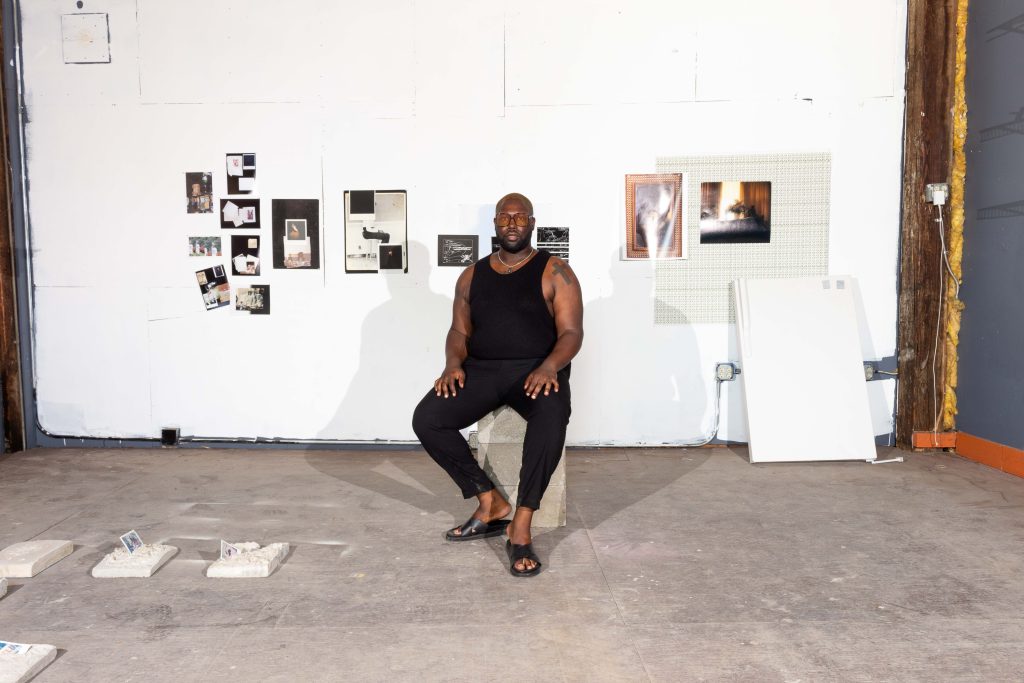
TH: I want to ask you about Artists in the Room. What was the motivation for starting it?
SJ: It really grew from [artists in the city] not feeling like there was space for us in these institutions. In St. Louis in particular, they were bringing in world-renowned Black artists. This was immediately after Mike Brown and Ferguson, when there was this influx of Black artists coming into the city of St. Louis. There was no desire on the institution’s behalf to connect those artists with the Black folks in the community. Through our own infiltration into some of these institutions, we were able to get in contact with [the visiting artists]. For some of the artists, we took it upon ourselves to connect them to the community at large. For the most part, all of the artists, including those who were coming into town, found it necessary. It was never meant to be anything where the artists felt like they had to do more work. It was really just for the act of building community, for us to continue to build networks—and for us to display the fact that there’s a vast amount of talent in St. Louis, in a city that’s often overlooked. Even often overlooked from within the city itself. Rikki Byrd, Lola Ayisha Ogbara, Danielle McCoy and myself came together as a collective and decided that we were going to do guerrilla warfare on these institutions and grab these Black folks up as they’re coming into town to immerse them in St. Louis Black culture. Artists in the Room is kind of on a hiatus because all of us are in various different spaces, and we’re still trying to figure out how to make something exist with all of us being in very different places in our lives, physically and in every other way.
TH: What I’ve been so inspired by are the projects like Artists in the Room that have very intentionally asked, “why not?” Instead of needing to be given permission, just doing it and creating what you need.
SJ: On one end, we were thinking about the artists in the community. But at the beginning stages, we didn’t realize that this was also something that these artists coming into the city were yearning for.
TH: … especially if they have their own ethics and approach to entering into cities and doing community-based work. It’s a beautiful thing to have these artists come into town. But I’m sure sometimes that they also are entering into these institutions asking, “where are my people at?” and wanting to see the people their work speaks to, the many communities that it might be.
What do you feel are the growth edges of your practice right now, whether that’s with the work or it’s with how you’re wanting to move your work in the world?
SJ: I’ve been moving away from the image in a very particular way. I’m really thinking about how to image things without having to use my camera. That’s an area of growth that I’m really interested in. It may [mean] being more sculptural or more performance. I’m really interested in things that aren’t as explicit. I’m inspired by the way that the concrete works with the images and how that, as the material itself, could stand for so many things. I’m still very much exploring and thinking about home.
I’m not bored with the image because I can never be bored with the image. There’s just so much rich material, they’re just so dynamic. But as my ethics continue to grow and not weigh down on me but [instead] hold me accountable, I’m really interested in ways that I can make without that aspect. Like from this place of memory, from this place of experience and not feeling limited to the camera or limited to the image. In some ways, it’s terrifying because it’s so vast and open. I like to have an answer. But I’m also excited about the possibilities of what can come with just using materials from the lens of my own memory, my own existence and how I can situate that amongst the image.
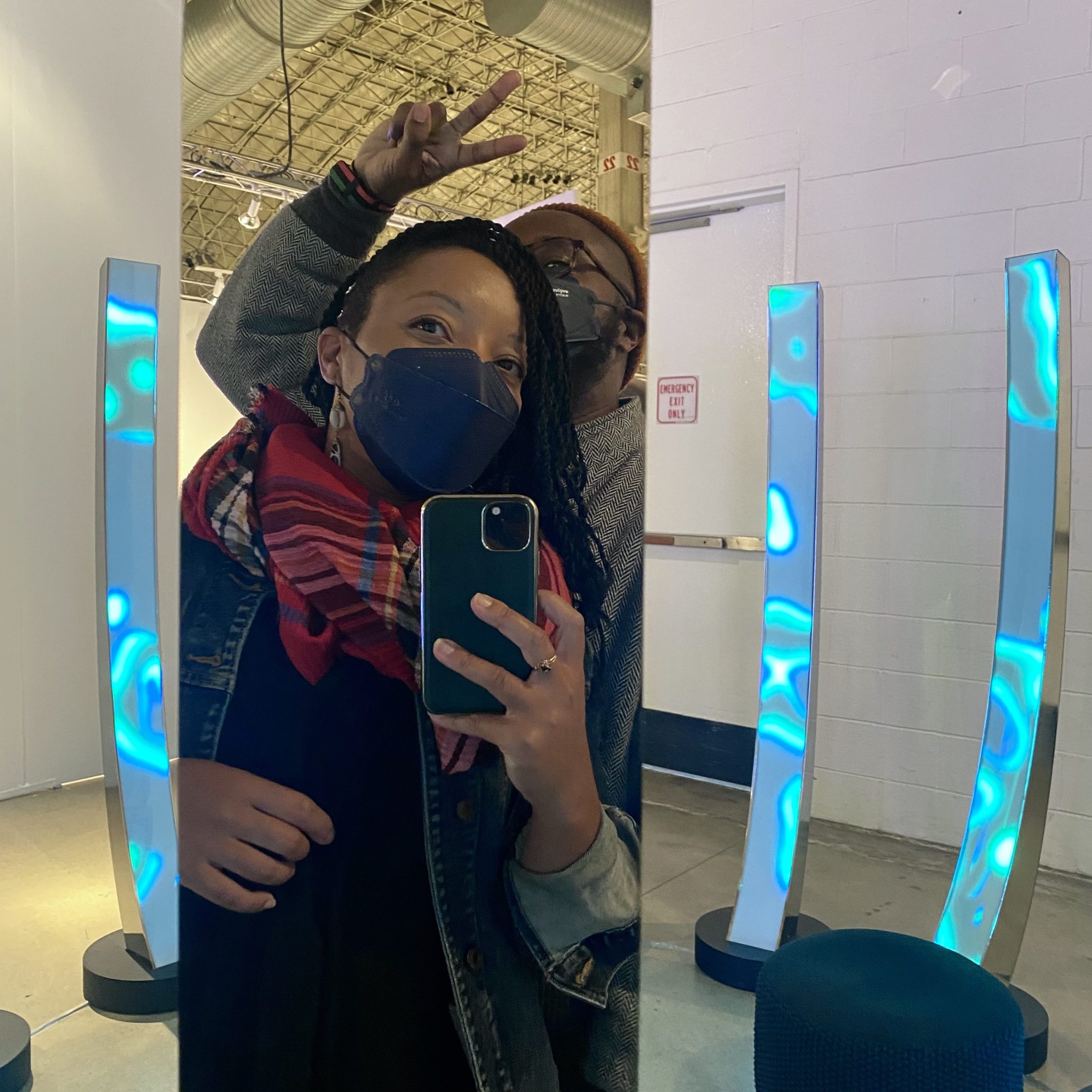
About the author: Tempestt Hazel is a curator, writer, and co-founder of Sixty Inches From Center. She often works alongside artists, organizers, grantmakers, and cultural workers to explore solidarity economies, cooperative models, archival practice, and systems change in and through the arts. You can see more of her editorial, curatorial, and other projects at tempestthazel.com.
